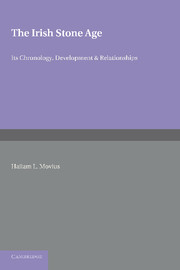Book contents
- Frontmatter
- Dedication
- Contents
- ILLUSTRATIONS
- FOREWORD
- PREFACE
- INTRODUCTION
- Part One THE CHRONOLOGY OF THE LATE-GLACIAL AND EARLY POST-GLACIAL PERIODS IN NORTHERN AND WESTERN EUROPE
- CHAPTER I The Chronology of Northern Europe
- CHAPTER II The Late-Glacial Sequence in Britain and Ireland
- CHAPTER III Early Post-Glacial Chronology in Britain and Ireland
- Part Two THE STONE AGE CULTURES OF IRELAND
- Appendices I-VI
- REFERENCES CITED IN THE TEXT
- CLASSIFIED LIST OF REFERENCES TO CAVE RESEARCH AND STONE AGE ARCHAEOLOGY IN IRELAND
- ADDENDUM
- INDEX
CHAPTER I - The Chronology of Northern Europe
from Part One - THE CHRONOLOGY OF THE LATE-GLACIAL AND EARLY POST-GLACIAL PERIODS IN NORTHERN AND WESTERN EUROPE
Published online by Cambridge University Press: 05 June 2016
- Frontmatter
- Dedication
- Contents
- ILLUSTRATIONS
- FOREWORD
- PREFACE
- INTRODUCTION
- Part One THE CHRONOLOGY OF THE LATE-GLACIAL AND EARLY POST-GLACIAL PERIODS IN NORTHERN AND WESTERN EUROPE
- CHAPTER I The Chronology of Northern Europe
- CHAPTER II The Late-Glacial Sequence in Britain and Ireland
- CHAPTER III Early Post-Glacial Chronology in Britain and Ireland
- Part Two THE STONE AGE CULTURES OF IRELAND
- Appendices I-VI
- REFERENCES CITED IN THE TEXT
- CLASSIFIED LIST OF REFERENCES TO CAVE RESEARCH AND STONE AGE ARCHAEOLOGY IN IRELAND
- ADDENDUM
- INDEX
Summary
INTRODUCTION
The recession of the last ice-sheets in Europe induced changes of far-reaching effect, which materially altered the shape and climate of the area, thus modifying the environment for plants, animals and man. The geographical events were of the first order, since they opened up and made available new land for human settlement, but the prime factor was climatic. In this changing world the Mesolithic cultures arose in Northern and Western Europe. One of them, which was chiefly centred in North-East Ireland, forms the main subject of this book. Therefore, if the archaeological data relating to this development are to be understood, the natural history of the area at the time of settlement must be established. This is the primary concern of the archaeologist, since therein rests the key to the interpretation of the material culture traits brought to light by excavation. But the problem is even more complex. It is also necessary to know the date of occupation in order that it may be fitted into the existing chronology of contiguous areas. Such a chronology has been established for Late-Glacial and Early Post-Glacial time in Northern Europe, but its extension into Western Europe— Britain and Ireland—has always rested on a somewhat nebulous foundation. The full picture that shows the close degree of similarity which exists between these two areas throughout the periods under discussion has not yet been reconstructed. It is not proposed to deal here extensively with the techniques which have been developed in order to compile the data; such discussions are better left to the specialist. However, the evidence itself, which offers the necessary chronological background for dating the archaeological sequence, will be outlined. In this chapter a brief summary of the history of Northern Europe during the Late-Glacial and Early Post-Glacial Periods is given, since this forms a basic pattern for the interpretation of the material in the two following chapters.
2. THE RECESSION OF THE LAST ICE-SHEET
During the peak of the last glaciation there were five independent centres of ice-dispersal in Northern and Western Europe: Novaya Zemlya and the North Urals, Fennoscandia, the Alps, the Pyrenees, and Great Britain and Ireland. In the latter region there were actually two principal independent sheets, but at the period of maximum advance these were confluent with each other.
- Type
- Chapter
- Information
- The Irish Stone AgeIts Chronology, Development and Relationships, pp. 3 - 24Publisher: Cambridge University PressPrint publication year: 2013



